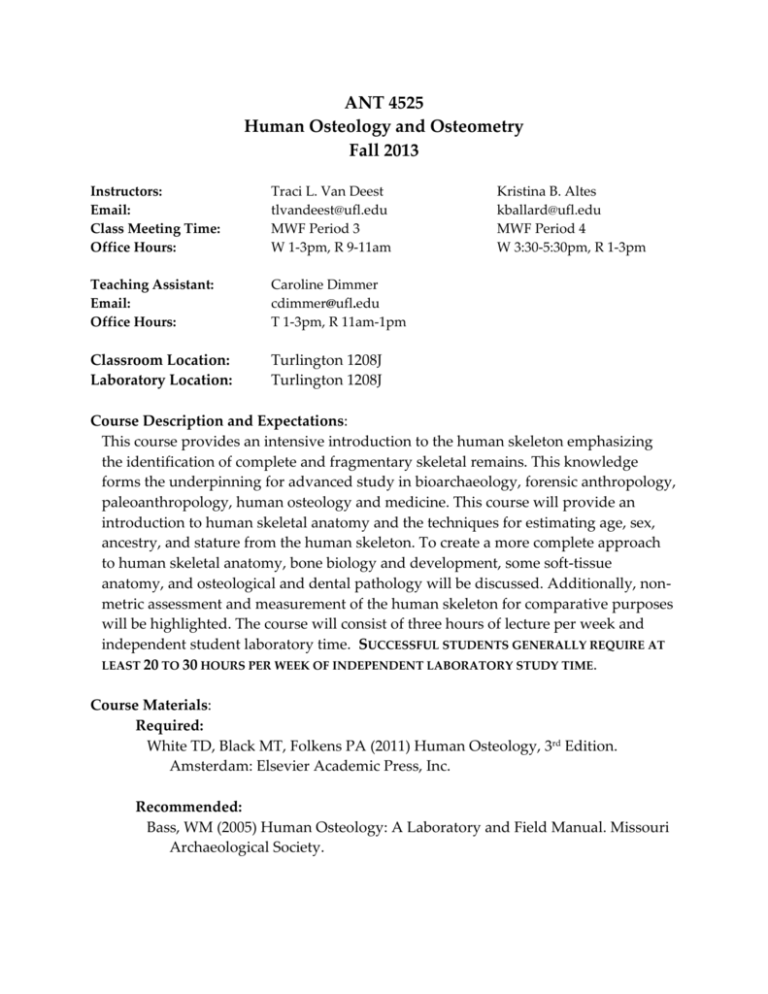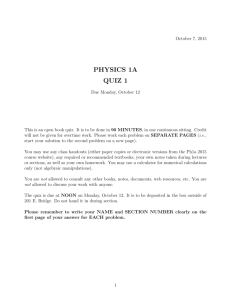Human Osteology and Osteometry - Anthropology at the University
advertisement

ANT 4525 Human Osteology and Osteometry Fall 2013 Instructors: Email: Class Meeting Time: Office Hours: Traci L. Van Deest tlvandeest@ufl.edu MWF Period 3 W 1-3pm, R 9-11am Teaching Assistant: Email: Office Hours: Caroline Dimmer cdimmer@ufl.edu T 1-3pm, R 11am-1pm Classroom Location: Laboratory Location: Turlington 1208J Turlington 1208J Kristina B. Altes kballard@ufl.edu MWF Period 4 W 3:30-5:30pm, R 1-3pm Course Description and Expectations: This course provides an intensive introduction to the human skeleton emphasizing the identification of complete and fragmentary skeletal remains. This knowledge forms the underpinning for advanced study in bioarchaeology, forensic anthropology, paleoanthropology, human osteology and medicine. This course will provide an introduction to human skeletal anatomy and the techniques for estimating age, sex, ancestry, and stature from the human skeleton. To create a more complete approach to human skeletal anatomy, bone biology and development, some soft-tissue anatomy, and osteological and dental pathology will be discussed. Additionally, nonmetric assessment and measurement of the human skeleton for comparative purposes will be highlighted. The course will consist of three hours of lecture per week and independent student laboratory time. SUCCESSFUL STUDENTS GENERALLY REQUIRE AT LEAST 20 TO 30 HOURS PER WEEK OF INDEPENDENT LABORATORY STUDY TIME. Course Materials: Required: White TD, Black MT, Folkens PA (2011) Human Osteology, 3rd Edition. Amsterdam: Elsevier Academic Press, Inc. Recommended: Bass, WM (2005) Human Osteology: A Laboratory and Field Manual. Missouri Archaeological Society. Buikstra JE, and Ubelaker D (1994) Standards for the Data Collection from Human Skeletal Remains. Fayetteville, AR: Arkansas Archeological Survey. Additional readings and handouts will be available on course E-Learning website (lss.at.ufl.edu). Course Requirements: There will be 9 cumulative practical quizzes (60 points each), 1 cumulative final practical exam (120 points), and one written assignment (100 points). The format for quizzes and the final exam will be discussed the first day of class. Due to the nature of the practical quizzes and exam, make-up quizzes/exams will be given only in documented illness or family emergency (http://www.registrar.ufl.edu/catalog1011/policies/regulationattendance.html), with warning of a missed exam at least 24 hours prior to the scheduled exam time. It is the student’s responsibility to inform the Instructor of any scheduled absences in advance; for the absence to be considered excused, both proper documentation and UF requirements must be met. The single lowest quiz score for each student will be dropped before computing the final grades for the course. Grades for the written assignment and the final practical exam cannot be dropped. Grades will be posted on the course E-learning website. The total earned points for the semester (from 8 highest quiz scores, final practical exam, and written assignment) will divided by the total available points (700 points) to calculate the final grade. Final grades will be strictly distributed according to the following scale: A AB+ B BC+ ≥ 92.50% 89.50% – 92.49% 86.50% – 89.49% 82.50% - 86.49 79.50% - 82.49% 76.50% - 79.49% C CD+ D DE 72.50% - 76.49% 69.50% - 72.49% 66.50% - 69.49% 62.50% - 66.49% 59.50% -62.49% ≤ 59.49% Information on current UF grading policies for assigning grade points can be found here: https://catalog.ufl.edu/ugrad/current/regulations/info/Grades.aspx Plagiarism and cheating in any form is subject to university policy as outlined by the Dean of Students (http://www.dso.ufl.edu/sccr/process/student-conduct-honor-code/ ) and will incur the severest allowable penalties. Attendance Policy: Attendance is expected at all scheduled lecture times, although attendance will not be taken. Please have the assigned readings completed before each lecture. If a handout applies to a class period, it will be in your best interest to bring a copy with you to lecture. Lectures will not be distributed outside of class, electronically or by the instructor for any reason. If you are unable to attend class, you must get the information covered that day from another student. Students with disabilities: Students requesting classroom accommodation must first register with the Dean of Students Office (http://www.dso.ufl.edu/drc). The Dean of Students Office will provide documentation to the student who must then provide this documentation to the instructor when requesting accommodation. This documentation must be presented to the instructor by the end of the second week of classes, in order for accommodations to be made within a timely manner. Students experiencing personal problems that are interfering with their academic performance are encouraged to contact the University Counseling Center (301 Peabody Hall, 392-1575), Student Mental Health (Student Health Care Center, 392-1171), or Sexual Assault Recovery Services (Student Health Care Center, 392-1161). Other Policies: Cell phones, iPods, MP3 players, and any other mobile device must be turned OFF during class time. Computers may be used for note taking purposes only during lectures; a privilege that can be revoked if necessary. NO photography or recording (audio or video) during lectures, inside the laboratory, or of skeletal remains. Read and sign a copy of the rules and turn it in to the Instructor by the date noted on the schedule. Failure to turn in a signed form will result in loss of osteology lab access privileges (a requirement for this class!). Rules for the Osteology Laboratory (Turlington Hall 1208J): The room is to remain secure at all times. If you leave, even for a few minutes, be sure the door is closed and locked. Access to the classroom and lab is controlled by a number pad lock. Students not granted access should not be permitted to enter the room. LOCK THE ROOM IF YOU ARE THE LAST STUDENT TO LEAVE THE ROOM. IF THE ROOM IS FOUND UNLOCKED, THE LAST STUDENT TO ACCESS THE ROOM USING THE KEYPAD WILL BE PENALIZED. Permission for visitors to the lab must be granted by the Instructor. NO EXCEPTIONS! Under no circumstances should a student not enrolled in this class be present in the laboratory without instructor consent. Certain Anthropology graduate students are permitted access to the laboratory for research purposes, and this is often time-sensitive. While they are advised to give osteology students priority for lab time, please be accommodating as lab availability is not always predictable. No specimens are to leave room 1208J Turlington Hall! NO PHOTOGRAPHY within the lab, of course materials, or skeletal remains. All skeletal and other materials are to be treated with the utmost respect. The laboratory is not a social center. Please be respectful of other students’ study time. Food and drink are prohibited in the laboratory. Failure to follow these rules will lead to point loss and/or dismissal from the class. I __________________________________(Print name) certify that I have read the above rules and understand that failure to comply will lead to point loss and/or dismissal from the course. Signed: ________________________________________ UFID: _________________________ Date: _________________________________ Fall 2013 Schedule: Subject to change with sufficient prior warning. W Topic Syllabus; Class rules; Ethics in Osteology Readings Ch 1, 17 23 F Anatomical terms and orientation/planes August 26 M Growth and Bone Structure August 28 W The Skull Ch. 2 Ch 3; Signed Laboratory Rules Form Due Ch. 4 August 30 F The Skull Ch. 4 September 2 M September 4 W No Class- Labor Day Cranial Soft Tissue and Nerves September 6 F Osteometry September 9 M Open Lab Review Time Month Date Day August 21 August pp.298-299, Handout pp.96-98, Buikstra and Ubelaker 1994 p74-84, Handout pp.389-391, 408-415, 421-424, Hefner 2009, Sauer 1992 September 11 W Non-metrics of Sex, Age, & Ancestry in the Cranium September 13 F Quiz 1 (Skull) September 16 M Dentition Ch 5 September 18 W September 20 F Dentition- Development and Age Estimation Vertebral column Ch. 5, pp.385-389 Ch 6 September 23 M Vertebral column September 25 W September 27 F September 30 M Thorax Quiz 2 (+ Dentition) Thorax October 2 W Clavicle and Scapula October 4 F Quiz 3 (+ Vertebral Column) October 7 M Musculature of the Upper Limb, Humerus October October October October October October 9 W 11 F 14 M 16 W Radius and Ulna Quiz 4 (+ Thorax, Shoulder Girdle) Hand Hand 18 F Quiz 5 (+ Arm and Forearm, Musculature) 21 M Os coxae 23 W Os coxae- Age and Sex Assessment October Ch. 6 Ch. 7 Ch 7 Ch 8 Ch. 9, pp.300-307, Handout Ch. 9 Ch 10 Ch 10 Ch 11 Ch 11, pp.394-404, 415-419 October October October 25 F 28 M 30 W November 1 F November 4 M November 6 W November 8 F November 11 M Quiz 6 (+ Hand) Musculature of the Lower Limb Femur and Patella Quiz 7 (+ Os Coxae, Musculature) Tibia and Fibula Foot NO CLASS – Homecoming NO CLASS- Veteran’s Day November 13 W Foot, Stature Estimation November 15 F Quiz 8 (+ Thigh and Leg) November 18 M Trauma and Pathology November 20 W November 22 F November 25 M November 27 W November 29 F December 2 M December 4 W Taphonomy Quiz 9 (+ Foot) Case studies NO CLASS – Thanksgiving Break NO CLASS- Thanksgiving Break Open Lab Review Time Final Practical Examination pp.308-316, Handout Ch 12 Ch 12 Ch. 13 Ch 13, Willey and Falsetti 1991, Ousley 1995, Written Assignment Due Ch. 19,Symes et al. 2012 Ch 20 Ch. 23, 25, 26




